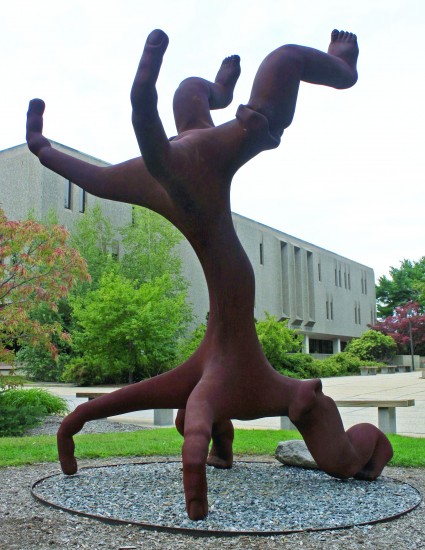
Photo by Hannah Plishtin
My defense of Putto 4 over 4 is based almost entirely upon sculptor Michael Rees’ defense of Putto 4 over 4. The “brown tree with human fingers and baby feet,” as I think I’ve heard it called, is undeniably unsettling, but that’s the point. Rees visited the Charles Chu Asian Art Reading Room on September 16 to speak about the piece.
The Putto series (there are several variations with different limb configurations) came out of Rees’ early conceptual image of a long cylinder with a hand at each end. He illustrated this by standing with his arms straight out at his sides parallel to the floor. He explained that a creature that looked like this would always have one side fighting the other, even if it were just trying to move.
“One side pushes, the other side pulls,” he said, clawing his hands at the air in a mock-scuttling gesture.
This sense of organic, internal conflict is absent in the rest of the sculpture around campus. Tony Rosenthal’s rotating geometric Cube, the black collage-inspired steel of Louise Nevelson, the interwoven cold silver tubes of Sasson Soffer’s Northern Memory & Southern Memory – none of these can match the visceral impact Putto has on viewers. Sure, it’s a grotesque piece, but we can relate to it as a figure, however bizarre.
Rees referred to the piece as a monster, and part of the process of coping with Putto is accepting this.
“Monsters are a great way to implant and evolve all kinds of information and knowledge,” Rees said. He went on to discuss some of his theories about the 2004 action movie Alien vs. Predator (while leaving out any mention of its 2007 sequel Alien vs. Predator: Requiem; this was probably for the best). He mentioned the climactic experience of seeing monsters’ heads and faces in movies and said he wanted to avoid something like that.
“To make it headless like that was to put this thing in the brainstem, back in the more primitive part of the brain. This is an instinctual creature. It’s an instinctual being. It’s not a thinker. It’s a doer; it’s an actor.” This makes the politics of Putto all the more explicit. It’s all muscle contractions and jerky movements without any contemplation. It’s reactionary, but it’s reacting to its other half while trying to interact with its environment.
An animated video of Putto (the twelve-foot tall sculpture represents one frame of this animation), realized with computer-aided design and the help of several animators, now plays continuously on a monitor on the first floor of the Charles E. Shain Library. The animation highlights Putto’s unthinking nature; the four-fingered, four-legged beast lumbers around blindly, flips itself over, hops on its freakish baby legs, and stretches its fingers. But despite its ugliness, it’s easy to feel sympathy for it as it dumbly struggles to gain its footing against a sterile, white backdrop. Obviously, Putto is a figment of Michael Rees’ imagination, but the empathy a viewer feels is real.
To be fair (and open-minded), it’s probably also easy not to feel affected by the alien Putto. The first time Rees showed the animation during a lecture, an audience member shouted from the back of the room, “IT AIN’T RIGHT!”
Rees reflected, “I loved that. ‘Cause it’s not.”
The artist thrives on the gut reactions of others to his work. The curator at the Richard Gehry-designed MARTa museum in Herford, Germany, a “very famous European,” whose name Rees was unable to remember, had not planned to show the animation along with the sculpture. When Rees pulled out his laptop to show him the video, he recoiled from the screen saying, “I would advise you never to show that to anyone!” The artist considered this to be a point scored, pumping his fist and loudly whispering “Got ‘em!”
Rees was engaging, enlightening and energetic, but he didn’t have to sell me on the merits of Putto. With its warm brown color, a texture that seems to alternate between smooth and coarse, it’s unlike any of the art we have on campus. And it’s certainly more interesting than Synergy by Conn alumna Frances Pratt – that unfortunately named, unfortunately placed, unfortunately colored tangle of stainless steel that serves as a welcome to so many visitors to our school (if they even notice it at all).
Putto is figurative and haunting, two words that cannot be used to describe any other sculpture on campus. It is confrontational and demands some kind of response from the viewer.
That this rough beast is located between Blaustein Humanities Center and the library is significant, too. It’s in the middle of everything – the center of our academic life. It’s there to be seen and to spark discussion; it’s there to be both loved and hated.
In the sculptor’s own words, “You can have a whole complex of relationships to this piece. And it can be discordant. That’s something I wanted. I wanted you to have a ‘that doesn’t make any sense – what the hell is that?’ experience.”








